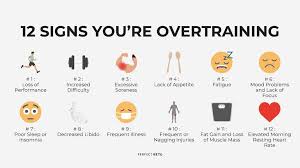Are you hitting the gym relentlessly but not seeing the results you expect? You may be experiencing overtraining, a condition that occurs when you push your body beyond its ability to recover. While dedication to fitness is admirable, overtraining can hinder your progress and even lead to adverse health effects.
In this article, we’ll explore what overtraining is, its symptoms, the science behind its impact on fitness gains, and actionable strategies to avoid it. By the end, you’ll have the knowledge to strike a balance between hard work and adequate recovery for optimal fitness results.
What Is Overtraining?
Overtraining, also known as overtraining syndrome (OTS), is a condition where an individual trains excessively without allowing sufficient time for recovery. It’s a common issue among athletes, fitness enthusiasts, and even beginners who are overly eager to achieve rapid results.
Causes of Overtraining
- Excessive Workout Volume: Performing too many sets, reps, or training sessions.
- Lack of Rest Days: Training daily without scheduled rest periods.
- Inadequate Nutrition: Failing to consume enough calories or nutrients to support recovery.
- High-Stress Levels: Combining physical stress from workouts with emotional or mental stress.
Types of Overtraining
- Sympathetic Overtraining: Linked to an overactive nervous system, resulting in heightened stress and irritability.
- Parasympathetic Overtraining: Characterized by chronic fatigue and low energy levels.
Symptoms of Overtraining
Recognizing overtraining early can prevent long-term setbacks. Common symptoms include:
Physical Symptoms
- Persistent muscle soreness
- Decreased performance despite consistent effort
- Chronic fatigue
- Increased risk of injuries
- Sleep disturbances
Psychological Symptoms
- Irritability and mood swings
- Lack of motivation
- Difficulty concentrating
Physiological Indicators
- Elevated resting heart rate
- Suppressed immune function (e.g., frequent colds)
- Hormonal imbalances, such as reduced testosterone levels in men or menstrual irregularities in women
The Science Behind Overtraining’s Impact on Fitness Gains
Muscle Growth and Recovery
Muscle growth (hypertrophy) occurs when the body repairs microtears in muscle fibers caused by resistance training. Overtraining disrupts this process by not allowing sufficient time for recovery, leading to a breakdown of muscle tissue instead of growth.
Hormonal Imbalances
Overtraining can increase cortisol (the stress hormone) while reducing anabolic hormones like testosterone and growth hormone. This hormonal imbalance impairs recovery, muscle repair, and overall performance.
Nervous System Fatigue
Continuous high-intensity training exhausts the central nervous system, reducing the body’s ability to generate force and coordinate movements. This leads to decreased performance and a heightened risk of injury.
How to Prevent Overtraining
Preventing overtraining is essential for achieving sustainable fitness progress. Here are effective strategies:
1. Prioritize Recovery
- Rest Days: Schedule at least one or two rest days per week.
- Sleep: Aim for 7-9 hours of quality sleep per night to promote recovery.
- Active Recovery: Engage in low-intensity activities like yoga or walking.
2. Follow a Balanced Training Program
- Incorporate variety by alternating between high- and low-intensity workouts.
- Avoid training the same muscle groups on consecutive days.
- Limit intense training sessions to 45-90 minutes.
3. Maintain Proper Nutrition
- Caloric Intake: Ensure you’re consuming enough calories to support your activity level.
- Macronutrients: Prioritize protein for muscle repair, carbs for energy, and healthy fats for hormonal balance.
- Hydration: Drink sufficient water to stay hydrated, especially after workouts.
4. Listen to Your Body
- Recognize signs of fatigue and scale back when needed.
- Use tools like heart rate monitors or fitness trackers to monitor recovery.
5. Seek Professional Guidance
- Consult a personal trainer or coach to design a program tailored to your needs.
- Periodically reassess your progress to make adjustments as necessary.
Recovering from Overtraining
If you suspect you’re overtrained, the following steps can help:
- Take a Break: Rest completely for several days to weeks, depending on the severity of overtraining.
- Reintroduce Exercise Gradually: Start with light, low-intensity activities before returning to your normal routine.
- Address Underlying Issues: Optimize sleep, nutrition, and stress management.
- Consult a Medical Professional: Seek advice if symptoms persist or worsen.
The Long-Term Risks of Ignoring Overtraining
Neglecting overtraining can lead to chronic issues such as:
- Persistent injuries
- Reduced bone density
- Long-term hormonal imbalances
- Burnout or quitting fitness altogether
Taking preventive measures not only protects your body but also ensures consistent progress towards your fitness goals.
Overtraining can derail your fitness journey by hindering performance, impairing recovery, and increasing the risk of injury. The key to avoiding overtraining lies in balancing intense training with adequate recovery, nutrition, and self-care. By understanding the signs and taking proactive measures, you can achieve sustainable fitness gains and enjoy a healthier lifestyle.
Remember, progress in fitness is a marathon, not a sprint. Listen to your body, train smart, and give yourself the time needed to recover and grow stronger.
Frequently Asked Questions (FAQ)
1. How can I tell if I’m overtraining?
Look for symptoms like persistent fatigue, decreased performance, mood swings, and frequent illnesses. Tracking your progress and resting heart rate can also help identify overtraining.
2. How many rest days should I take per week?
Most individuals benefit from 1-2 rest days per week, depending on their training intensity and fitness level.
3. Can overtraining affect mental health?
Yes, overtraining can lead to irritability, mood swings, and a lack of motivation, significantly impacting mental well-being.
4. Is it possible to recover from severe overtraining?
Yes, but recovery may take weeks or months. Focus on complete rest, proper nutrition, and addressing underlying factors.
5. What are the best ways to balance training and recovery?
Follow a structured training program, prioritize rest and sleep, maintain a nutritious diet, and listen to your body’s signals.
By implementing these strategies, you can maximize your fitness gains while safeguarding your health and well-being.